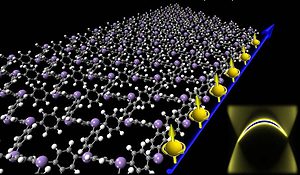Researchers at University of Utah have recently demonstrated that it is indeed feasible to construct a topological insulator from organic compounds. Topological insulators are deemed very important by scientists because of their unique property of conducting electrons on their edges, while at the same time acting as an insulator on the inside. These capabilities make it an ideal component for quantum computing, key for unlocking some of the Universe’s well kept secrets and for pushing technology in a new age.

Insulators came in two types. The most common and well known are the “ordinary” insulators, where electrons fully occupy energy bands and thus keep electricity from flowing. One of the best ordinary insulators are considered diamonds. Now, topological insulators on the other hand are a lot more interesting. In these types of materials the spin-orbit interaction is so strong that the insulating energy gap is inverted — the states that should have been at high energy above the gap appear below the gap. As a result, we have highly conducting metallic states on the surface, while the inside is completely insulated.
Feng Liu, professor and chair of materials science and engineering at University of Utah, lead a team of scientists that proved that organic topological insulators can be created after they performed theoretical calculations to predict the existence of an organic topological insulator using molecules with carbon-carbon bonds and carbon-metal bonds, called an organometallic compound.
“This is the first demonstration of the existence of topological insulators based on organic materials,” says Liu. “Our findings will broaden the scope and impact of these materials in various applications from spintronics to quantum computing.”
In order for a material to behave like a topological insulator it needs to shuttle information at light speed or in other words be able to transmit fermions – massless or weightless packets of light that conduct electricity as they move along the material surface. Dirac fermions have a property called spin, or angular momentum around the particle’s axis that behaves like a magnetic pole. So using dirac fermions, scientists can use another way of encoding information, either signaled by “clockwise” or “counterclockwise” according to the spin of the fermions.
“We have demonstrated a system with a special type of electron – a Dirac fermion – in which the spin motion can be manipulated to transmit information,” Liu says. “This is advantageous over traditional electronics because it’s faster and you don’t have to worry about heat dissipation.”
Organic topological insulators have been rather poorly studied compared to conventional topological insulators, however if finally synthesized, organic topological insulators could mean such materials could be created a lot cheaper, easing production.
Findings were reported in a paper published in the journal Nature Communications.
source: Uni Utah press release / image copyright University of Utah.






